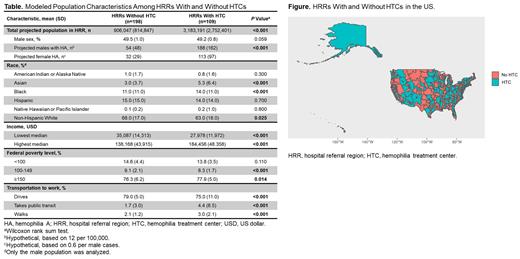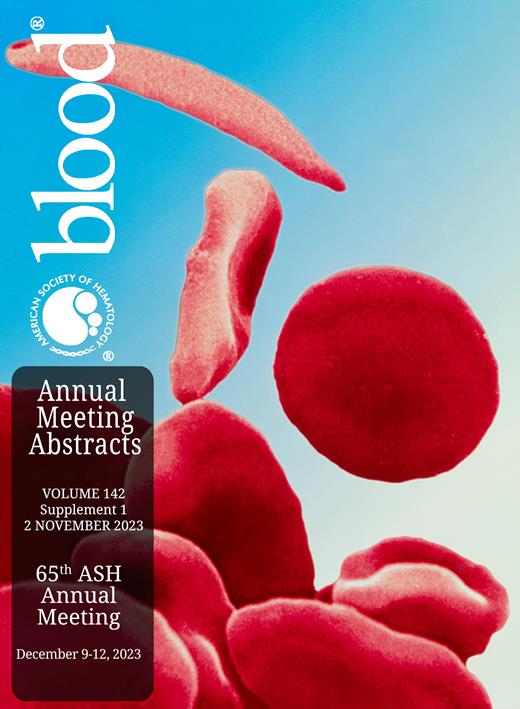Introduction: Among the approximately 53,000 people with hemophilia A (PwHA) in the US, a majority receive care at federally supported hemophilia treatment centers (HTCs). PwHA treated at HTCs have more favorable outcomes and are more likely to receive advanced therapies than PwHA receiving care external to the HTC network. Identifying geographic, socioeconomic and racial disparities among populations residing in hospital referral regions (HRRs) with and without HTCs will support efforts to improve care access and advance health equity.
The objective of this study was to evaluate geographic, socioeconomic and racial differences in modeled US populations of PwHA who reside within HRRs with and without HTCs.
Methods: Characteristics of HRRs with and without HTCs were compared using the Centers for Disease Control and Prevention (CDC) HTC listings. The study cohorts included individuals who resided in HRRs with and without an HTC based on modeled US populations of projected PwHA (pPwHA). The number of males with hemophilia A in each HRR was calculated at a rate of 12 cases per 100,000 males in the region of interest based on CDC estimates, and the number of females who were carriers of hemophilia A was calculated at a rate of 0.6 female carriers per male case as defined by the International Society of Thrombosis and Haemostasis Scientific and Standardization Committee. Demographic characteristics for each HRR were derived from the 2020 5-year American Community Survey; zip code tabulation areas were crosswalked to 5-digit zip codes and aggregated to HRRs.Differences in population characteristics in HRRs with and without HTCs were evaluated for statistical significance using the Wilcoxon rank sum test.
Results: In 307 HRRs in the US, 109 had an associated HTC, while 198 did not (Figure). However, larger mean (SD) populations comprised HRRs with HTCs than those without (3,183,191 [2,752,401] vs 906,047 [814,847]; P<0.001; Table). Findings from this modeling work indicate that 78% of pPwHA reside in HRRs with an HTC. HRRs with HTCs served populations with greater proportions of Asian (5.3% vs 3.0%) and Black (14% vs 11%) individuals than those without HTCs ( P<0.001 for both). Compared with those in HRRs without HTCs, individuals residing in HRRs with HTCs had a wider range of median incomes ($27,978-$184,456 vs $35,087-$138,168; P<0.001) and a greater likelihood of falling above the 150% federal poverty line (77.9% vs 76.3%; P=0.014). Additionally, those residing in HRRs with HTCs were less likely to drive to work (75.0% vs 79.0%) and more likely to take public transit (4.4% vs 1.7%) or walk (3.0% vs 2.1%) than people in HRRs without HTCs ( P<0.001 for all).
Conclusions: This analysis estimated that in the US, 4 of 5 pPwHA reside in an HRR with HTC access. HRRs with HTCs served larger populations with greater racial and socioeconomic diversity than HRRs without HTCs. While it is possible that PwHA who reside in HRRs without HTCs can still receive adequate care via outreach clinics, mobile units or virtual appointments, this work highlights that geographic barriers to HTC access remain incompletely addressed. Future efforts should focus on accurately identifying US hemophilia A populations and their locations relative to HTCs and comparing the impact on care and outcomes in those who rely on outreach efforts or mobile programs.
Disclosures
Raimundo:F. Hoffmann-La Roche Ltd.: Current equity holder in publicly-traded company; Genentech, Inc.: Current Employment. Schuldt:F. Hoffman-La Roche Ltd.: Current equity holder in publicly-traded company; Genentech, Inc.: Current Employment. Recht:Partners in Bleeding Disorders: Membership on an entity's Board of Directors or advisory committees; uniQure: Consultancy, Research Funding; NovoNordisk: Research Funding; LFB: Research Funding; Takeda: Consultancy, Research Funding; Grifols: Research Funding; BioMarin: Research Funding; CSL Behring: Consultancy, Research Funding; Bayer Pharmaceuticals: Research Funding; Sanofi: Consultancy, Research Funding; Genentech, Inc.: Consultancy, Research Funding; Hema Biologics: Consultancy, Research Funding; ATHN: Membership on an entity's Board of Directors or advisory committees; Pfizer: Consultancy.


